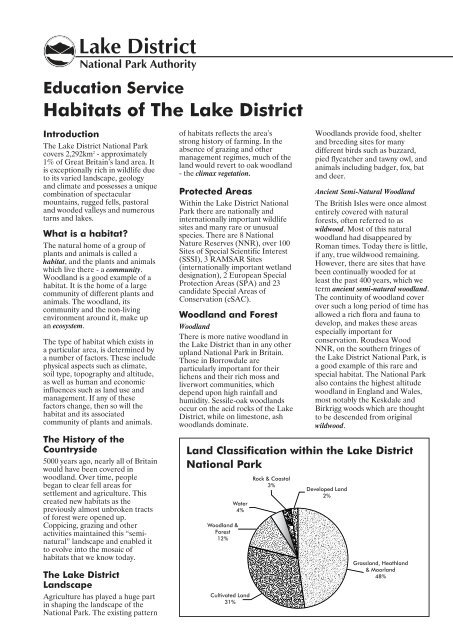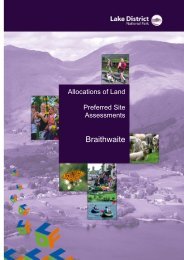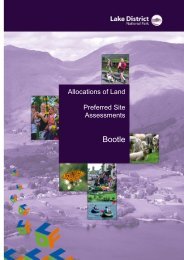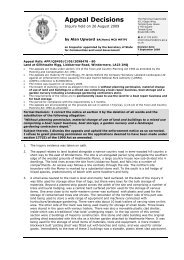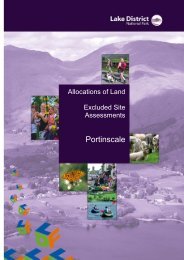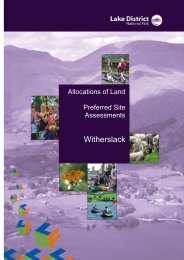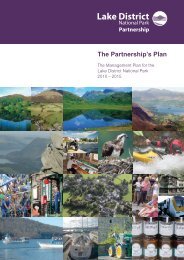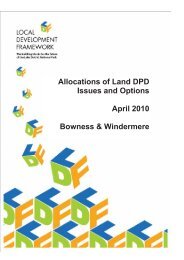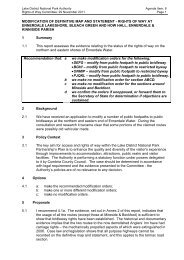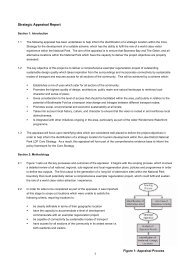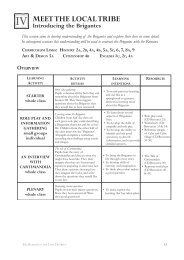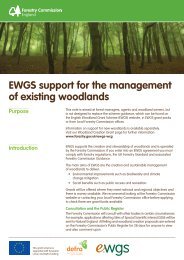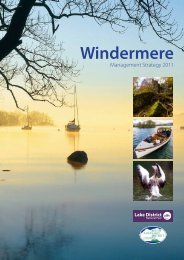Habitats - Lake District National Park
Habitats - Lake District National Park
Habitats - Lake District National Park
Create successful ePaper yourself
Turn your PDF publications into a flip-book with our unique Google optimized e-Paper software.
Education Service<br />
<strong>Habitats</strong> of The <strong>Lake</strong> <strong>District</strong><br />
Introduction<br />
The <strong>Lake</strong> <strong>District</strong> <strong>National</strong> <strong>Park</strong><br />
covers 2,292km 2 - approximately<br />
1% of Great Britain’s land area. It<br />
is exceptionally rich in wildlife due<br />
to its varied landscape, geology<br />
and climate and possesses a unique<br />
combination of spectacular<br />
mountains, rugged fells, pastoral<br />
and wooded valleys and numerous<br />
tarns and lakes.<br />
What is a habitat?<br />
The natural home of a group of<br />
plants and animals is called a<br />
habitat, and the plants and animals<br />
which live there - a community.<br />
Woodland is a good example of a<br />
habitat. It is the home of a large<br />
community of different plants and<br />
animals. The woodland, its<br />
community and the non-living<br />
environment around it, make up<br />
an ecosystem.<br />
The type of habitat which exists in<br />
a particular area, is determined by<br />
a number of factors. These include<br />
physical aspects such as climate,<br />
soil type, topography and altitude,<br />
as well as human and economic<br />
influences such as land use and<br />
management. If any of these<br />
factors change, then so will the<br />
habitat and its associated<br />
community of plants and animals.<br />
The History of the<br />
Countryside<br />
5000 years ago, nearly all of Britain<br />
would have been covered in<br />
woodland. Over time, people<br />
began to clear fell areas for<br />
settlement and agriculture. This<br />
created new habitats as the<br />
previously almost unbroken tracts<br />
of forest were opened up.<br />
Coppicing, grazing and other<br />
activities maintained this “seminatural”<br />
landscape and enabled it<br />
to evolve into the mosaic of<br />
habitats that we know today.<br />
The <strong>Lake</strong> <strong>District</strong><br />
Landscape<br />
Agriculture has played a huge part<br />
in shaping the landscape of the<br />
<strong>National</strong> <strong>Park</strong>. The existing pattern<br />
of habitats reflects the area’s<br />
strong history of farming. In the<br />
absence of grazing and other<br />
management regimes, much of the<br />
land would revert to oak woodland<br />
- the climax vegetation.<br />
Protected Areas<br />
Within the <strong>Lake</strong> <strong>District</strong> <strong>National</strong><br />
<strong>Park</strong> there are nationally and<br />
internationally important wildlife<br />
sites and many rare or unusual<br />
species. There are 8 <strong>National</strong><br />
Nature Reserves (NNR), over 100<br />
Sites of Special Scientific Interest<br />
(SSSI), 3 RAMSAR Sites<br />
(internationally important wetland<br />
designation), 2 European Special<br />
Protection Areas (SPA) and 23<br />
candidate Special Areas of<br />
Conservation (cSAC).<br />
Woodland and Forest<br />
Woodland<br />
There is more native woodland in<br />
the <strong>Lake</strong> <strong>District</strong> than in any other<br />
upland <strong>National</strong> <strong>Park</strong> in Britain.<br />
Those in Borrowdale are<br />
particularly important for their<br />
lichens and their rich moss and<br />
liverwort communities, which<br />
depend upon high rainfall and<br />
humidity. Sessile-oak woodlands<br />
occur on the acid rocks of the <strong>Lake</strong><br />
<strong>District</strong>, while on limestone, ash<br />
woodlands dominate.<br />
; y<br />
;; yy ;; yy<br />
;;; yyy<br />
;; yy ; y<br />
;;; yyy ;;;<br />
;; yy<br />
; y<br />
;;;<br />
;; yy<br />
;;;<br />
Woodlands provide food, shelter<br />
and breeding sites for many<br />
different birds such as buzzard,<br />
pied flycatcher and tawny owl, and<br />
animals including badger, fox, bat<br />
and deer.<br />
Ancient Semi-Natural Woodland<br />
The British Isles were once almost<br />
entirely covered with natural<br />
forests, often referred to as<br />
wildwood. Most of this natural<br />
woodland had disappeared by<br />
Roman times. Today there is little,<br />
if any, true wildwood remaining.<br />
However, there are sites that have<br />
been continually wooded for at<br />
least the past 400 years, which we<br />
term ancient semi-natural woodland.<br />
The continuity of woodland cover<br />
over such a long period of time has<br />
allowed a rich flora and fauna to<br />
develop, and makes these areas<br />
especially important for<br />
conservation. Roudsea Wood<br />
NNR, on the southern fringes of<br />
the <strong>Lake</strong> <strong>District</strong> <strong>National</strong> <strong>Park</strong>, is<br />
a good example of this rare and<br />
special habitat. The <strong>National</strong> <strong>Park</strong><br />
also contains the highest altitude<br />
woodland in England and Wales,<br />
most notably the Keskdale and<br />
Birkrigg woods which are thought<br />
to be descended from original<br />
wildwood.<br />
Land Classification within the <strong>Lake</strong> <strong>District</strong><br />
<strong>National</strong> <strong>Park</strong>
Coppicing<br />
In the past, woodlands have<br />
played an important role in local<br />
industries and traditional crafts<br />
such as hurdle making, basket<br />
weaving and charcoal production.<br />
Evidence of this can still be found<br />
in many woods in the form of<br />
coppice stools. Coppicing is a<br />
woodland management technique<br />
that can be traced to Neolithic<br />
times. Trees are cut to near ground<br />
level on a short rotation. The<br />
stump then sends up shoots from<br />
which poles can be harvested.<br />
Species such as the high brown<br />
fritillary butterfly, and its food<br />
plant, violet, benefit from the<br />
substantial light penetration to the<br />
woodland floor which this regime<br />
allows.<br />
Forest<br />
Conifer plantations occupy large<br />
areas of the <strong>Lake</strong> <strong>District</strong>. They<br />
often contain fast growing tree<br />
species such as spruce and pine<br />
which are favoured by commercial<br />
timber growers, but support only a<br />
limited range of wildlife. Compared<br />
to native broadleaved woodlands,<br />
conifer plantations are quite<br />
impoverished. They are used by<br />
several birds of prey including<br />
sparrowhawk, goshawk and merlin<br />
and provide refuge, feeding and<br />
nesting areas for the native red<br />
squirrel.<br />
Recent moves towards more varied<br />
planting and felling patterns are<br />
producing a mosaic of smaller stands<br />
of different aged trees. These are<br />
more botanically diverse and of<br />
much greater value to wildlife.<br />
Threats to Woodland<br />
Overgrazing by stock and deer is<br />
perhaps the greatest cause of decline<br />
in natural regeneration of<br />
broadleaved woodlands. A diverse<br />
age structure within a woodland is<br />
vital to ensure the long term survival<br />
of the habitat and its associated<br />
species. In some areas where<br />
regeneration is not occuring<br />
naturally, woodland management<br />
such as stock proof fencing and<br />
coppicing is being undertaken.<br />
Alien Invaders<br />
Ornamental species introduced by<br />
the Victorians such as<br />
rhododendron and laurel have<br />
escaped from the private gardens<br />
for which they were intended and<br />
spread into surrounding<br />
woodland, out-competing native<br />
species. Their dense canopy<br />
prevents light from reaching the<br />
woodland floor and the roots<br />
produce toxic chemicals that<br />
prevent other plants from growing.<br />
This makes the surrounding soil<br />
very acidic and reduces the species<br />
diversity of woodlands.<br />
Grasslands<br />
The <strong>National</strong> <strong>Park</strong> has many<br />
different kinds of grassland,<br />
reflecting the diversity of rocks,<br />
climate and topography. Before<br />
people began to clear the forests for<br />
agriculture and settlement, open<br />
grassland was a rare feature below<br />
the treeline. Most grasslands have<br />
been created by humans and grazing<br />
animals. Some areas have been<br />
drained, ploughed and re-seeded<br />
with “improved” grass mixtures for<br />
agriculture and so have limited<br />
wildlife value. Others remain as<br />
unimproved pasture which supports<br />
a greater diversity of plants and<br />
animals.<br />
Acid Grassland<br />
Acid grassland is common on upland<br />
sheep pasture where high rainfall,<br />
coupled with a long history of<br />
burning and grazing, has favoured<br />
this relatively species-poor habitat.<br />
However, the invertebrate species<br />
associated with grasslands provide a<br />
vital food source for birds such as<br />
skylark and meadow pipit along with<br />
small mammals such as mouse and<br />
vole. Acid grasslands often contain<br />
small areas of richer habitat in the<br />
form of wet flushes, springs and<br />
mires where many interesting plants,<br />
such as the insectivorous sundew and<br />
butterwort, can be found.<br />
Calcareous Grassland and Limestone<br />
Pavement<br />
Calcareous grassland occurs on the<br />
limestone outcrops in the <strong>Lake</strong><br />
<strong>District</strong>. Whitbarrow NNR is a fine<br />
example of this internationally<br />
important habitat. The area is<br />
dominated by blue moor-grass,<br />
which is locally abundant but<br />
nationally rare. Uncommon orchids<br />
and distinctive plants, such as crested<br />
hair-grass, also occur, along with<br />
several species of breeding butterfly.<br />
Limestone Pavement<br />
During the last ice age, huge glaciers<br />
scoured the bedrock of the <strong>Lake</strong><br />
<strong>District</strong>. In limestone areas this<br />
created a smooth, flattened surface<br />
which is characteristic of limestone<br />
pavements. Weathering and run-off<br />
from rainwater widened and<br />
deepened any cracks in the rock<br />
giving rise to a complex pattern of<br />
solid blocks called clints, separated<br />
by fissures known as grikes.<br />
These habitats form distinctive<br />
niches for a range of plants and<br />
animals. Rare ferns thrive in the<br />
deep shady crevices or grikes, while<br />
above you may catch a glimpse of the<br />
Duke of Burgundy or other rare<br />
butterflies.<br />
Clint<br />
Grike<br />
Limestone pavement is a nationallyrare<br />
habitat of international<br />
importance. Outside Britain,<br />
pavement can be found in only a few<br />
other areas of Europe. Cumbria<br />
holds 36% of Britain’s limestone<br />
pavement and examples at<br />
Whitbarrow NNR are some of the<br />
finest in Britain.<br />
Threats to Limestone Pavement<br />
Limestone has been extracted for<br />
decades, to build walls and gateposts,<br />
but demand for stone to use in<br />
decorative rockeries has grown<br />
rapidly over the last 40 years.<br />
Commercial exploitation of the<br />
pavements has led to large scale<br />
destruction of this fragile habitat.<br />
Today, most pavement in England is<br />
protected by Limestone Pavement<br />
Orders, but this legislation does not<br />
extend to Eire where this rare<br />
habitat continues to be depleted.
Neutral grassland<br />
Haymeadows occur on neutral<br />
grassland. They support a rich<br />
variety of wild flowers, a diverse<br />
sward of grasses and provide nectar<br />
for invertebrates. Their richness is<br />
maintained by the fact that plants<br />
can flower and set seed before<br />
mowing, enabling them to be<br />
dispersed during summer<br />
haymaking. Sandybeck Meadow in<br />
the North West of the <strong>Lake</strong> <strong>District</strong><br />
<strong>National</strong> <strong>Park</strong> is the smallest NNR in<br />
England at just 0.3 ha but it<br />
represents a good example of this<br />
declining habitat.<br />
Threats to Haymeadows<br />
Many haymeadows have been lost<br />
over recent years due, in part, to the<br />
intensification of agriculture. The<br />
move away from hay making towards<br />
silage production which requires an<br />
earlier cut and often relies on the<br />
input of artificial fertiliser, has led to<br />
a considerable loss of species<br />
diversity on many grasslands or<br />
pastures.<br />
Upland Heath<br />
Heathland is an open habitat<br />
dominated by dwarf shrubs such as<br />
heather. It is thought that areas were<br />
originally cleared for agriculture, but<br />
their poor acidic soils made them<br />
unsuitable for farming. This enabled<br />
the acid tolerant heather to colonise<br />
the land. These open habitats are<br />
particularly important for insects.<br />
Over 170 species of butterfly and<br />
moth have been identified at<br />
Rusland Moss NNR in the south of<br />
the <strong>National</strong> <strong>Park</strong>, along with moths,<br />
spiders, flies, beetles, birds and<br />
reptiles.<br />
Large areas of upland heath have<br />
traditionally been managed as<br />
shooting estates. A diverse age<br />
structure of vegetation is maintained<br />
through systematically burning strips<br />
of heather to promote seed<br />
germination and encourage the<br />
growth of new shoots. This practice<br />
ensures a constant food supply for<br />
birds, such as the red grouse, and<br />
provides important breeding ground<br />
for (among others), Britain’s<br />
smallest bird of prey, the merlin.<br />
Threats to Heathland<br />
Heathlands need careful<br />
management to prevent them<br />
reverting to woodland. This is<br />
commonly achieved through stock<br />
grazing. However if stocking<br />
densities are too high the<br />
regeneration of heather cannot keep<br />
pace with the consumption of young<br />
shoots by the sheep and the heather<br />
dies back. This continues to be a<br />
problem in many areas of upland<br />
Britain including the <strong>Lake</strong> <strong>District</strong>.<br />
Financial incentives aimed at<br />
tackling overgrazing have been<br />
introduced as part of the<br />
Government’s Environmentally<br />
Sensitive Areas scheme.<br />
The Environmentally Sensitive<br />
Areas Scheme (ESA)<br />
In the 1980’s the government<br />
designated the first English<br />
‘Environmentally Sensitive Areas’.<br />
These are nationally-valued parts<br />
of the British countryside that<br />
need careful management by<br />
farmers if they are to retain their<br />
character and continue to support<br />
a rich network of wildlife. The<br />
<strong>Lake</strong> <strong>District</strong> <strong>National</strong> <strong>Park</strong> was<br />
designated as an ESA in 1993 and<br />
financial incentives are used to<br />
encourage environmentallyfriendly<br />
farming.<br />
Farmers are asked to reduce<br />
chemical inputs such as fertilisers<br />
and pesticides, to safeguard and<br />
restore hedges, drystone walls,<br />
traditional farm buildings and<br />
archaeological remains and to<br />
take care of wildlife habitats such<br />
as flower-rich hay meadows,<br />
heather moor, wetlands, chalk<br />
downland and native woods. They<br />
are also encouraged to restore and<br />
recreate these features.<br />
Mires<br />
The cool wet climate of the <strong>Lake</strong><br />
<strong>District</strong> provides ideal conditions for<br />
the development of peat, and the<br />
area is considered to be of national<br />
importance for both the extent and<br />
quality of its mires. Peat is<br />
characteristic of waterlogged<br />
conditions and consists of partiallydecomposed<br />
plant material. In areas<br />
where soil micro-organisms cannot<br />
complete their natural breakdown<br />
processes due to highly acidic<br />
conditions and a lack of oxygen,<br />
organic remains accumulate as peat.<br />
Many mires are nutrient-poor<br />
ecosystems, unsuitable for farming.<br />
The vegetation depends almost<br />
entirely on dilute nutrient supplies<br />
present in rainwater and<br />
atmospheric dust. Mosses and<br />
liverworts flourish along with many<br />
species of lichen and dwarfed forms<br />
of heathers and sedges.<br />
Blanket mire is an internationallyscarce<br />
habitat which is particularly<br />
important for breeding moorland<br />
birds such as red grouse, golden<br />
plover and merlin. Many sites have<br />
become impoverished through<br />
burning, grazing and drainage, but<br />
extensive areas remain on some of<br />
the flatter fell tops within the<br />
<strong>National</strong> <strong>Park</strong>.<br />
Small fragments of raised mire also<br />
occur within the <strong>National</strong> <strong>Park</strong>, and<br />
these too are of international<br />
importance. Meathop Moss is one of<br />
the best remaining examples of a<br />
raised mire in south Cumbria. The<br />
moss supports a wide range of plants,<br />
over 200 species of butterfly and<br />
moth and several species of<br />
dragonfly and damselfly. It was one<br />
of the first nature reserves in the<br />
country and is now a SSSI.<br />
Threats to Mires<br />
Like many wildlife habitats, mires<br />
were once more numerous and<br />
extensive but have been depleted by<br />
the activities of man. Vast tracts<br />
have disappeared over the past 100<br />
years mainly as a result of<br />
reclamation for agriculture and<br />
horticulture. Artificial drainage of<br />
sites, coupled with the increased<br />
demand for peat by gardeners, has<br />
led to a widespread decline of this<br />
wetland habitat. To try to reverse<br />
this situation, attempts are being<br />
made to raise gardeners’ awareness<br />
of alternatives for soil conditioning<br />
(such as home-made compost), and<br />
steps are being taken to protect and<br />
manage existing mires more<br />
sympathetically. A few have been<br />
re-wetted and are managed by<br />
controlling water levels. In areas<br />
where rare plants such as the bog<br />
orchid have been found, grazing has<br />
been controlled.<br />
<strong>Lake</strong>s & Tarns<br />
<strong>Lake</strong>s and tarns make a vital<br />
contribution to the identity and<br />
beauty of the <strong>National</strong> <strong>Park</strong>. They<br />
support an exceptional variety of<br />
aquatic plants and animals, and are<br />
of national and international<br />
importance for nature conservation.<br />
The lakes were formed in the last ice<br />
age by huge glaciers gouging out<br />
depressions which were later filled<br />
by meltwater and rain. They vary<br />
considerably in their size, depth and<br />
nutrient status. Some have a long<br />
tradition of recreational use, access<br />
and facilities, while others are valued<br />
for their tranquil and relatively<br />
undisturbed atmosphere.<br />
The deep, cold lakes of Buttermere,<br />
Ennerdale and Wastwater provide<br />
habitat for a restricted range of<br />
plants and animals, including some<br />
rare crustaceans specifically adapted<br />
to nutrient-poor environments.
In contrast, lakes such as<br />
Windermere and Bassenthwaite<br />
<strong>Lake</strong> support a more diverse range<br />
of species. Their more wooded<br />
shorelines, with shallow bays and<br />
areas of reedbed, provide valuable<br />
nesting haunts for swans, grebes and<br />
other birds. Windermere is of<br />
national importance for wintering<br />
wildfowl.<br />
Bassenthwaite <strong>Lake</strong> is very rich in<br />
aquatic plants including the<br />
nationally-scarce floating water<br />
plantain, and is one of only two lakes<br />
in Britain known to support the fish<br />
vendace. Bassenthwaite <strong>Lake</strong> was<br />
designated a NNR in 1993 and is<br />
owned and managed by the <strong>National</strong><br />
<strong>Park</strong> Authority. In 2001 the first pair<br />
of ospreys to nest in northern<br />
England for 150 years, bred near the<br />
shores of Bassenthwaite <strong>Lake</strong>.<br />
Threats to the <strong>Lake</strong>shore Environment<br />
On many of the lakes and tarns<br />
recreational use can sometimes<br />
conflict with nature conservation<br />
interests. The lakeshore habitat is a<br />
fragile “soft shore” environment that<br />
is highly susceptible to erosion. The<br />
trampling action of feet, coupled<br />
with grazing by livestock and waves<br />
created from passing boats, can lead<br />
to soil and organic material being<br />
washed away. Over time, the reedy<br />
shoreline may begin to resemble a<br />
pebble beach which contains only a<br />
fraction of the invertebrate species<br />
and little or no aquatic vegetation.<br />
Erosion of a stony shore<br />
A stony shore<br />
hydrosere with<br />
all herbs and<br />
grasses …<br />
reduced by<br />
trampling to a<br />
grass sward<br />
which<br />
subsequently<br />
breaks up …<br />
leading to<br />
erosion of the<br />
surface and<br />
exposure of<br />
tree roots …<br />
This eventually<br />
results in the<br />
loss of lakeside<br />
trees and<br />
formation of a<br />
gravel beach<br />
Rivers<br />
Many of the rivers within the<br />
<strong>National</strong> <strong>Park</strong> are of considerable<br />
ecological importance. The<br />
significant populations of fish,<br />
together with other species such as<br />
native crayfish, freshwater pearl<br />
mussel and otter, reflect the<br />
generally high standards of water<br />
quality. The fast flowing upland<br />
streams provide ideal conditions for<br />
birds such as dippers and grey<br />
wagtails.<br />
Rock and Scree<br />
Glacial activity has produced a wide<br />
variety of crags, knolls, ledges and<br />
other rock features. In some places,<br />
steep sided gills cut deeply into the<br />
fellsides. These ravines provide a<br />
damp, sheltered environment and<br />
are largely inaccessible to grazing<br />
animals, which enables them to<br />
support many unusual plants.<br />
Steep rocky cliffs known locally as<br />
crags support a mosaic of plant life,<br />
with a mixture of arctic-alpine flora<br />
and lowland plant species. Sheltered<br />
rock ledges support a rich<br />
assemblage of tall herbs and ferns<br />
along with many mosses, liverworts<br />
and flowering plants. They also<br />
provide a habitat for a varied range<br />
of bird species including stonechat,<br />
wheatear and ring ouzel and nest<br />
sites for raven, peregrine and golden<br />
eagle.<br />
The population of<br />
peregrine falcons<br />
suffered huge<br />
declines during<br />
the 1950s and<br />
1960s due to<br />
widespread use<br />
of pesticides,<br />
and illegal<br />
persecution. Their<br />
numbers dropped to just<br />
6 pairs in Cumbria.<br />
However over the last 20<br />
years they have made a<br />
considerable recovery. The <strong>Lake</strong><br />
<strong>District</strong> today supports the highest<br />
density of peregrines anywhere in<br />
Europe.<br />
Threats to Rock and Scree<br />
Cliff, rock and scree communities<br />
are very easily damaged. They are<br />
vulnerable to the activities of<br />
climbers, walkers and scramblers.<br />
Many agencies are working in<br />
partnership to promote responsible<br />
and sensitive use of the countryside.<br />
Seasonal access restrictions to crags<br />
with nesting birds are negotiated<br />
annually. An Environmental Charter<br />
for outdoor users in the <strong>Lake</strong><br />
<strong>District</strong> has recently been produced<br />
by the Adventure and Environment<br />
Awareness Group.<br />
Coastal Environments<br />
Coastal environments include areas<br />
of dune, grazing marshes, coastal<br />
heath, mudflats and the banks of<br />
tidal rivers. Five sites of international<br />
importance for nature conservation<br />
are located on the coast of the<br />
<strong>National</strong> <strong>Park</strong>.<br />
In the West, the <strong>National</strong> <strong>Park</strong>’s<br />
coast stretches from Drigg Local<br />
Nature Reserve (SSSI) for 19km<br />
south to Silecroft. Large numbers of<br />
the internationally-important<br />
natterjack toad are found here along<br />
with the palmate, great crested and<br />
smooth newt. Other important<br />
species include the adder, slow<br />
worm, 18 nationally important<br />
invertebrates and over 200 plant<br />
species.<br />
On its southern boundary the<br />
<strong>National</strong> <strong>Park</strong> encompasses small<br />
parts of the Duddon Estuary and<br />
Morecambe Bay. These extensive<br />
areas support huge numbers of<br />
breeding and wintering birds for<br />
which they are awarded special<br />
European protection – RAMSAR<br />
status.<br />
Conservation<br />
Many organisations help protect<br />
<strong>Lake</strong> <strong>District</strong> habitats. They include<br />
the <strong>National</strong> Trust, English Nature,<br />
Royal Society for the Protection of<br />
Birds and Cumbria Wildlife Trust.<br />
The <strong>Lake</strong> <strong>District</strong> <strong>National</strong> <strong>Park</strong><br />
Authority works closely with these<br />
organisations to monitor important<br />
habitats and ensure they are<br />
protected and maintained for future<br />
generations.<br />
© <strong>Lake</strong> <strong>District</strong> <strong>National</strong> <strong>Park</strong> Authority,<br />
Education Service,<br />
<strong>Lake</strong> <strong>District</strong> Visitor Centre,<br />
Brockhole, Windermere,<br />
Cumbria LA23 1LJ<br />
Web site: www.lake-district.gov.uk<br />
Copyright waived for classroom use<br />
Alternative formats<br />
available from 015394 40800


